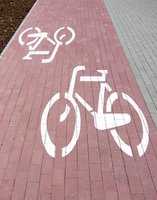Bicycling Strategy Paper
Bicycling Strategy Report Summary
 This paper will introduce bicycling as a planning strategy, review the existing conditions and the potential for improving the conditions for bicycling in the region, and examine the effects of implementing this strategy. This paper is intended to be a planning tool—to initiate dialogue and discussion on the possible impacts of improving bicycling conditions in our region.
This paper will introduce bicycling as a planning strategy, review the existing conditions and the potential for improving the conditions for bicycling in the region, and examine the effects of implementing this strategy. This paper is intended to be a planning tool—to initiate dialogue and discussion on the possible impacts of improving bicycling conditions in our region.
This paper examines the impacts of improved bicycle facilities on transportation, health, the environment, the economy, and community character. Improvement could take the form of new bikeways, changes to existing transportation infrastructure to make bicycling easier and safer, new laws or ordinances protecting or promoting cyclists, educational and outreach programs designed to encourage and increase bicycling, or even enforcement programs intended to improve safety for bicyclists and other users of roadways and paths. Our research represents an attempt to answer the broad question: "What would happen, regionally and in your communities, if the region improved bicycling conditions?"
Key Questions:
- What should CMAP's role be in the planning and implementation of bicycle facilities? As a regional agency, how active should we be in seeking to improve bicycle conditions?
- What would be the overall effect of improving bicycle facilities in your community? What positives and negatives would come from this? What would be the most effective and appropriate way for your community to improve its bicycle facilities?
- If bicycle facilities were improved by communities across the region, what would the overall effects be, both on your community and region-wide?
A sample of findings:
Primary Transportation Impacts
- Research has shown that the creation of new bicycle facilities does lead to an increase in trips being made by bicycle. Some of these trips are recreational, but some are trips that might otherwise be made by car.
- Bicycle facilities will increase access to transit and will lead to an increase in transit ridership. Bicycle facilities increase the catchment area for trips to transit, because more people will be able to reach the station without a car. The amount to which this occurs depends on conditions surrounding transit stations.
- More people on their bikes and taking transit will lead to a decrease in average vehicle miles traveled (VMT).
Primary Health Impacts
- Even a moderate amount of physical exercise improves a number of health outcomes. Bicycling, as a form of transportation that involves exercise, has been proven to improve health.
To learn more about this report or ask questions, please contact John ONeal, JONeal (at)cmap.illinois.gov
|
Links |